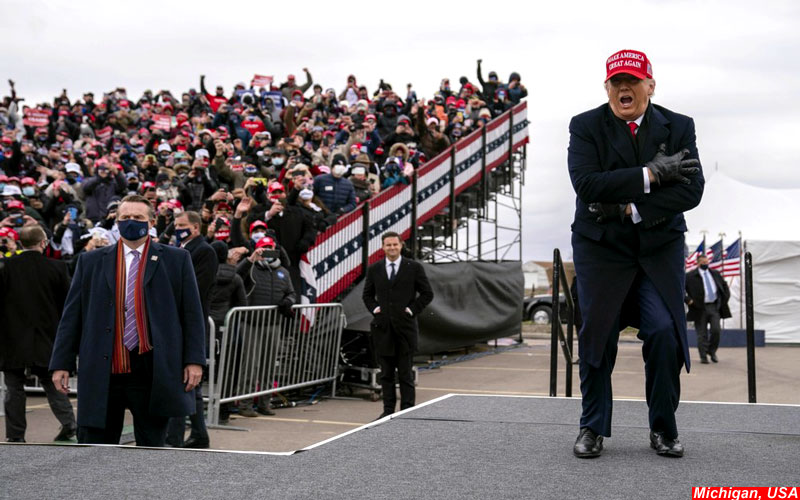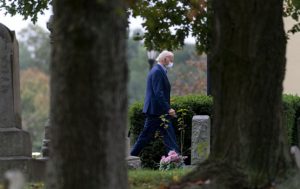
WASHINGTON, United States (AP) — U.S President Donald Trump on Sunday launched one final test of whether the large crowds at his rallies will translate into votes as he races through the final 48 hours of the 2020 campaign with an onslaught of events in the states that could decide the race.
A rally north of Detroit on a frigid morning kicked off a frenzied blitz of campaigning over the last two days before the election, with nine more rallies to go. Down in the polls and at a cash disadvantage to Democrat Joe Biden, Trump is turning to these large gatherings to help keep his message in front of voters.
It’s unclear whether the rallies will broaden his appeal beyond those people already likely to vote for him, and the packed — often unmasked — crowds risk deepening the pandemic at a time when coronavirus cases are rising.
But Trump, still relishing his late surge against Hillary Clinton in 2016, sees his showmanship as a central element of his outsider appeal that he hopes will resonate once more.
He began the final push in Washington, Michigan, at an outdoor rally with whipping winds and temperatures that felt well below freezing.
“This is a hell of a day. You guys must love Trump, this place is packed,” said Trump, who jokingly complained throughout his speech about the cold. “It’s really a contest to see if we can all stand it. And we’ll get through it. And we’ll love it.”
With more than 91 million votes already cast, Trump and Biden are out of time to reshape the race. Instead, they’re focusing on their base and making sure that any potential supporters have either already voted or plan to do so in person on Tuesday.
For Biden, that means paying close attention to Black voters who are a critical part of the coalition he needs to build to win. His team is confident in Biden’s standing with women, college-educated voters and suburbanites.
His campaign must now ensure that voters of color show up in force to support Biden, which will be especially critical in fiercely competitive states such as Pennsylvania and Michigan.
The challenge is exacerbated by the Democratic push this year to encourage voting by mail to prevent people waiting in long lines during a pandemic. But that runs counter to the tradition of some Black voters who prefer to vote in person on Election Day.
“Most Black voters in Philly have been skeptical of mail-in voting,” said Joe Hill, a veteran Democratic operative-turned-lobbyist from the city. “A lot of us have gotten our ballots already,” Hill said, but added, “Election Day has always been everything in Philadelphia.”
Biden planned to spend much of Sunday in Philadelphia encouraging voters to turn out. He was to participate in a “souls to the polls” event aimed at encouraging Black church congregations to organize and vote.

He held his first in-person campaign events with Barack Obama on Saturday in the predominantly Black cities of Detroit and Flint, Michigan. The former president will campaign for Biden on Monday in Georgia and in South Florida, another area of potential concern if Latino voters sit out the election.
As the largest city in a state that could decide the presidency, Philadelphia has always held special significance for Biden. Just 30 miles from his longtime home in Wilmington, Delaware, Biden established his campaign headquarters in Philadelphia before the pandemic forced most of his staff to work remotely.
The city gets intense focus because it’s such a deep trove of Democratic votes, especially nonwhite voters.
Clinton lost Pennsylvania by almost 45,000 votes four years ago even as she fell just 4,800 votes shy of Obama’s Philadelphia County total in 2012. Clinton’s bigger problem was that she lost ground to Trump in other parts of the state beyond Philadelphia and its suburbs.
According to an analysis by University of Florida professor Michael McDonald, a nonpartisan political data expert, almost 2.3 million Pennsylvania voters had returned absentee ballots as of Friday out of almost 3.1 million requested. That’s a statewide return rate of 74.2%.
Philadelphia’s return rate was a tick higher, at 74.6%, but it had the highest raw total of outstanding ballots, with more than 101,000. Statewide, registered Democrats maintained a solid advantage over Republicans on returned ballots: 1.54 million to about 520,000. In a separate analysis, the Democratic data firm TargetSmart found that more than 385,000 of the early Democratic voters didn’t vote at all in 2016.
Across the state in Pittsburgh, Democratic consultant Mike Mikus stressed that Philadelphia isn’t Biden’s only path to flipping Pennsylvania. Mikus noted that Trump won a Pittsburgh-area congressional district by nearly 20 percentage points in 2016 only to watch Democrat Conor Lamb win a special congressional election there a year later. Lamb won a full term in 2018 and is heavily favored again Tuesday.
Mikus said that trend will help Biden run up a wide margin in Allegheny County, the state’s second most populous.
“He’s got a real base, but there’s just no evidence that he’s done anything to reach anybody who didn’t already like him in 2016,” Mikus said, “and he’s lost people who weren’t sure about him but were willing to take the gamble. … It’s not just about Philadelphia.”
____
Newsroom | theworldmail.co.uk
Source/Contribution/Photo Credit by Associated Press






